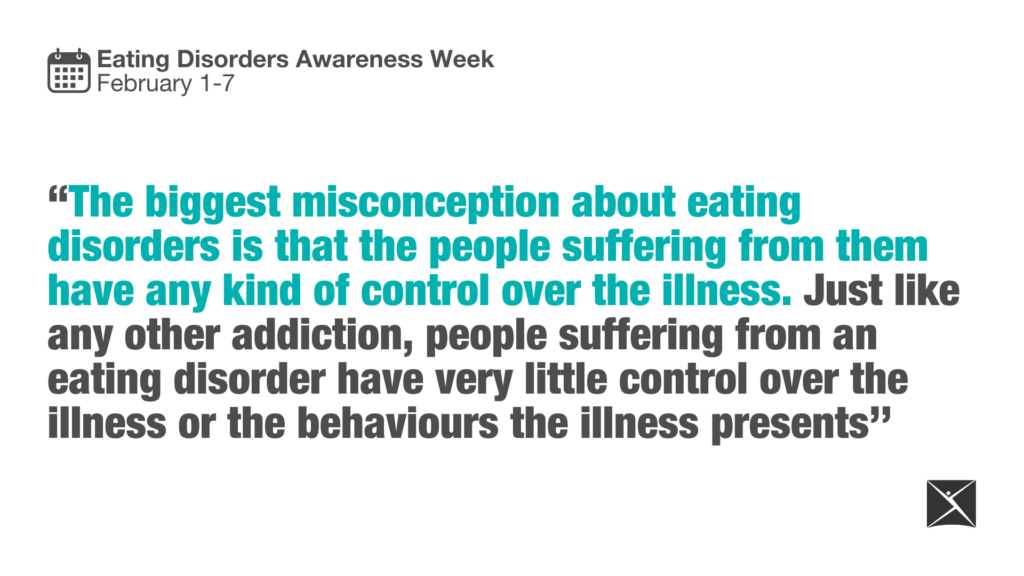Menu
Close

Eating Disorders Awareness Week: February 1st to 7th
Feb 5, 2025
CMHA Peel Dufferin recognizes Eating Disorders Awareness Week (EDAW) from February 1st to 7th, a time dedicated to raising awareness and challenging the stigma surrounding eating disorders. Eating disorders are serious mental health conditions that impact individuals of all genders, ages, races, and socioeconomic backgrounds. They are not simply about food but rather a way of coping with deeper emotional struggles. This week, we encourage open conversations about eating disorders and the importance of seeking support and treatment.
Understanding Eating Disorders
When someone has an eating disorder, their weight is the prime focus of their life. Their all-consuming preoccupation with calories, grams of fat, exercise, and weight allows them to displace the painful emotions or situations that are at the heart of the problem and gives them a false sense of being in control. Read more about the details and types of eating disorders below.
Facts About Eating Disorders
Eating disorders are often difficult to recognize due to societal pressures around body image and dieting. Many individuals struggle to admit they have a problem, making it challenging for loved ones to offer support. However, treatment is available, and recovery is possible. Understanding the facts about eating disorders is the first step toward supporting oneself or others on the path to wellness.
Recent Statistics and Regional Insights
An estimated 2.7 million Canadians, including 1.4 million youth, are affected by eating disorders (National Initiative for Eating Disorders, 2023). These conditions often emerge during adolescence, with anorexia nervosa typically developing in the mid- to late-teen years (Statistics Canada, 2023). Eating disorders also have the highest mortality rate among mental illnesses, with estimates ranging from 10-15% (National Eating Disorder Information Centre, 2019). In Ontario, pediatric hospitalizations for eating disorders increased by 139% between 2002 and 2019, with a notable rise among males (416%) and younger adolescents aged 12-14 (196%) (PMC, 2023). The COVID-19 pandemic has further exacerbated the issue, with a reported 11,289 hospitalizations for eating disorders among Canadians aged 6 to 20 from April 2016 to March 2023, 77% of which involved girls aged 12 to 17 (Parents, 2023).
Anorexia Nervosa, Bulimia Nervosa, and Binge-Eating Disorders
Three chronic eating disorders have been identified:
Anorexia Nervosa is characterized by severe weight loss due to extreme food reduction. Symptoms include:
- Refusal to keep body weight at or above the normal weight for one’s body type
- Dieting to extremes, usually coupled with excessive exercise
- Feeling overweight despite dramatic weight loss
- Loss of menstrual periods
- Extreme preoccupation with body weight and shape
Bulimia Nervosa results in frequent fluctuations in weight due to periods of uncontrollable binge eating, followed by purging. As well as a preoccupation with body image, symptoms include:
- Repeated episodes of bingeing and purging, usually by self-induced vomiting, abuse of laxatives, diet pills, and/or diuretics – methods which are both ineffective and harmful
- Eating beyond the point of fullness
Binge-eating disorder, or compulsive eating, is often triggered by chronic dieting and involves periods of overeating, often in secret and often carried out as a means of deriving comfort. Symptoms include:
- Periods of uncontrolled, impulsive, or continuous eating
- Sporadic fasts or repetitive diets
Warning Signs
When someone has an eating disorder, their weight is the prime focus of their life. Their all-consuming preoccupation with calories, grams of fat, exercise, and weight allows them to displace the painful emotions or situations that are at the heart of the problem and gives them a false sense of being in control.
Other warning signs include:
- Low self-esteem
- Social withdrawal
- Claims of feeling fat when weight is normal or low
- Preoccupation with food, weight, counting calories, and with what people think
- Denial that there is a problem
- Wanting to be perfect
- Intolerance of others
- Inability to concentrate
Causes
There is no single cause. An eating disorder generally results from a combination of factors. Psychological factors include low self-esteem, feelings of inadequacy or lack of control, depression, anger, or loneliness. Interpersonal factors include troubled family and personal relationships, difficulty expressing emotions and feelings, and a history of physical or sexual abuse. Media promotion of unrealistic images and goals, along with its tendency to equate a person’s value with their physical appearance, is another contributor.
The possibility of biochemical or biological causes is being studied. Some people with eating disorders have been found to have an imbalance of chemicals in the brain that control hunger, appetite, and digestion, possibly as a result of the disorder.
What Can I Do?
If you are struggling with an eating disorder, you are not alone. Many men and women have eating disorders, and there is no shame in asking for help. The problem is too big to fix on your own and help and support are available.
If you think someone you know has an eating disorder, learn what you can about these conditions. Express your concerns calmly and in a caring way. You can’t force someone to change their behavior, but you can let them know that you care and want to support them. Encourage the person to seek professional help. Don’t lay blame, and focus discussions on feelings, not food. Examine your own issues around food and weight. Be supportive, but do not enable the behavior.
This Eating Disorders Awareness Week, let’s challenge stigma, increase awareness, and encourage open conversations about eating disorders. Recovery is possible, and support is available.
